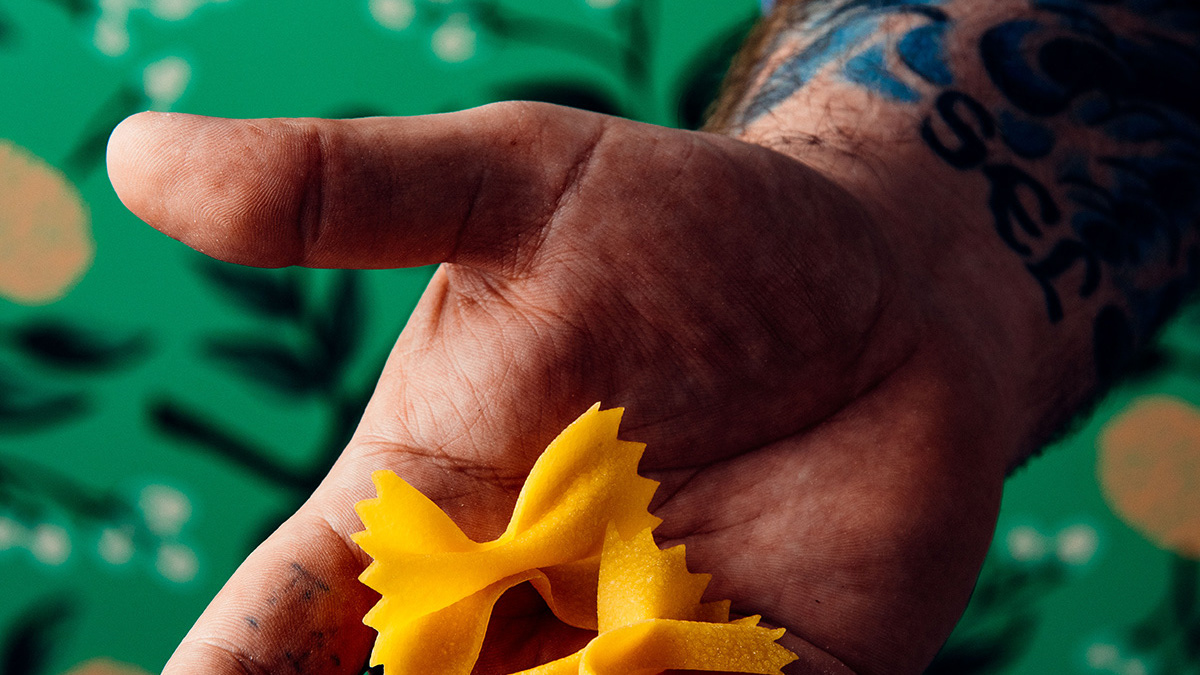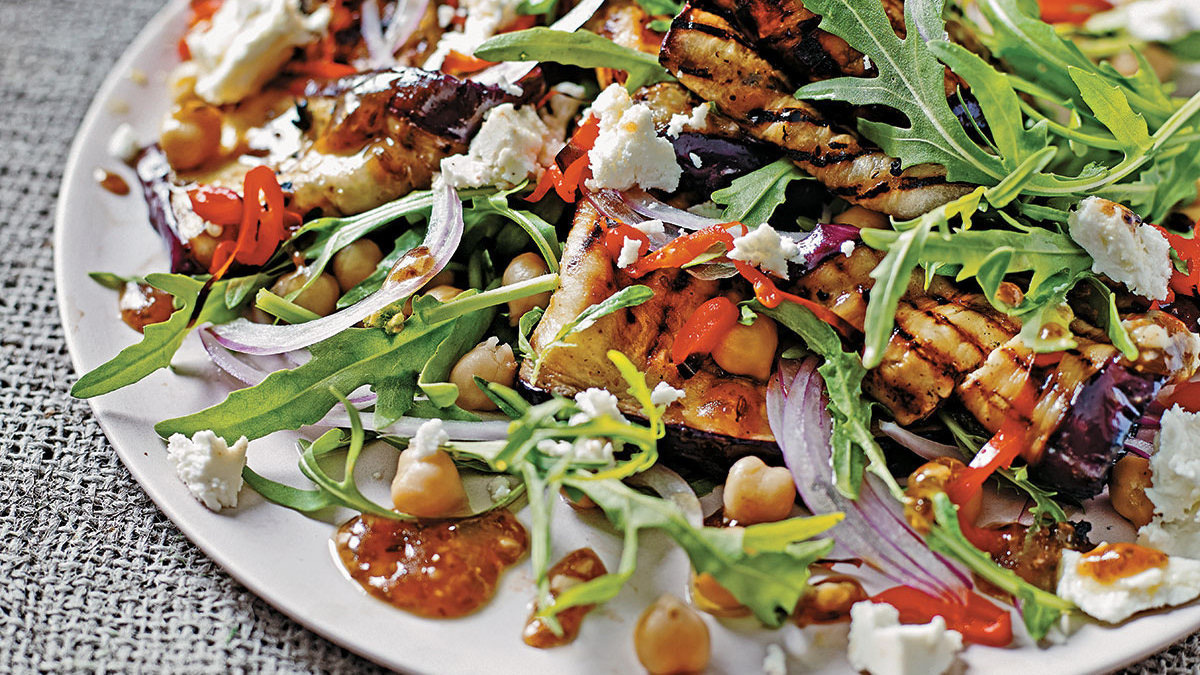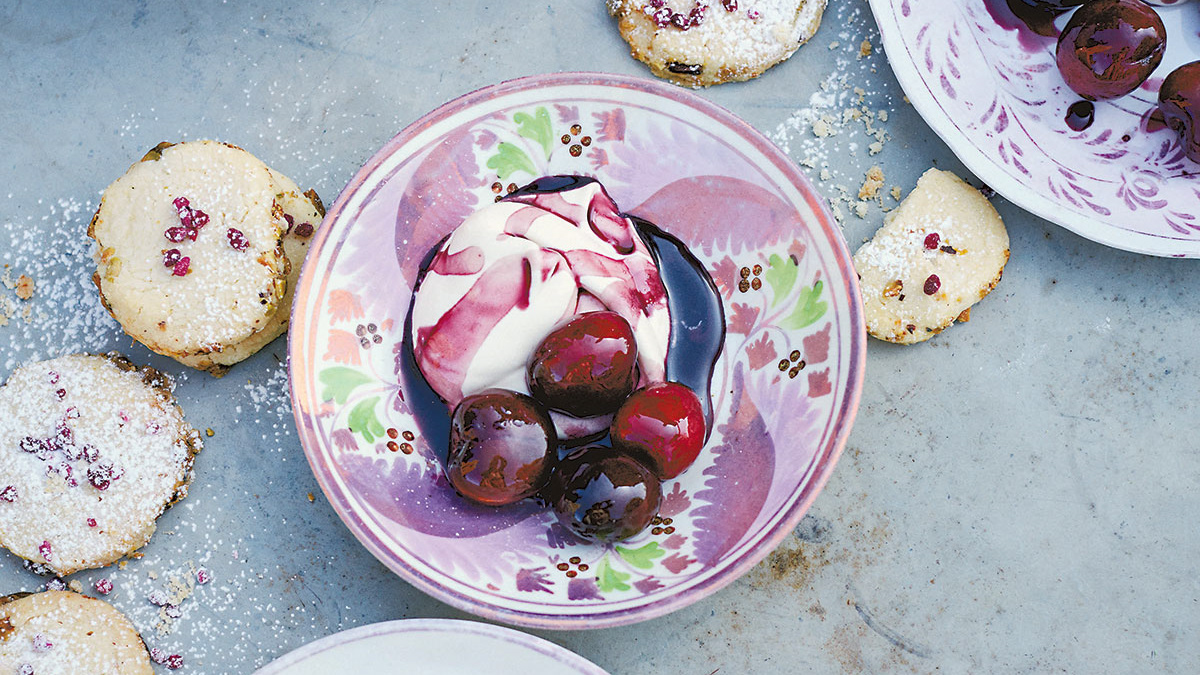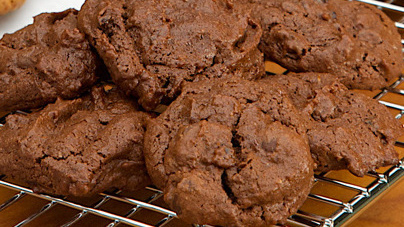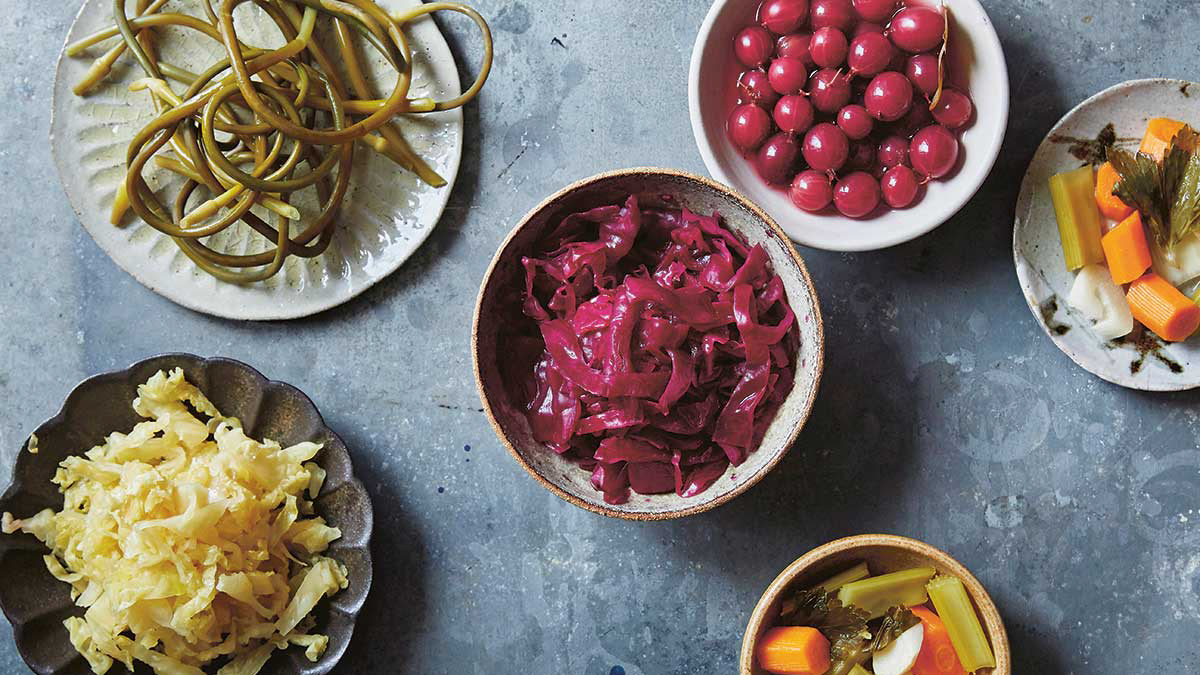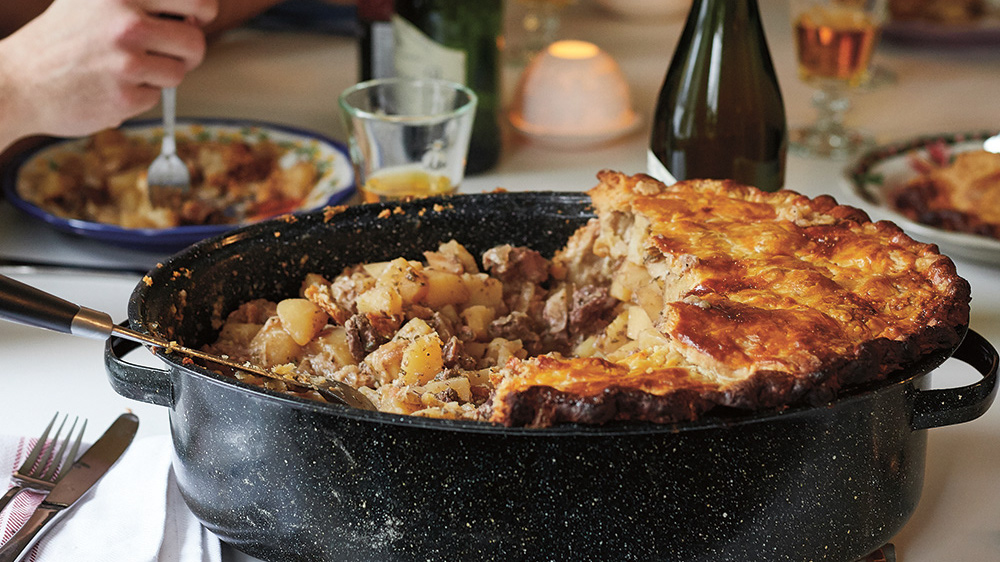PHOTO: Appetite by Random House Canada; Na’ama’s Fattoush from Jerusalem: A Cookbook by Yotam Ottolenghi and Sami Tamimi.
Laura Brehaut/Postmedia News
Originally published on October 29, 2012; canada.com
Originally published on October 29, 2012; canada.com
Za'atar, tahini, fresh lemon juice and plenty of herbs – London-based Israeli chefs Yotam Ottolenghi and Sami Tamimi believe that if readers acquaint themselves with the wonderful flavours of Jerusalem's cuisine, their job is done.
PUBLISHED IN PRINT:
Calgary Herald: November 3, 2012; pages H1-H2
Calgary Herald: November 3, 2012; pages H1-H2
Za’atar, tahini, fresh lemon juice and plenty of herbs – London-based Israeli chefs Yotam Ottolenghi and Sami Tamimi believe that if readers acquaint themselves with the wonderful flavours of Jerusalem’s cuisine, their job is done.
The co-authors and business partners were both born in Jerusalem in the same year and grew up in different parts of the city: Ottolenghi in the Jewish west, and Tamimi in the Arab east. The two didn’t meet until almost 30 years later after they had both settled in London. Their friendship led to a business partnership and they now run five restaurants together – four branches of deli-style Ottolenghi, and fine dining NOPI – and recently wrote a cookbook celebrating the food of their shared hometown, Jerusalem: A Cookbook (Appetite by Random House, 2012). The book follows Ottolenghi’s New York Times bestseller, Plenty (Chronicle Books, 2011) and their co-written Ottolenghi: The Cookbook (Ebury Press, 2008).
As Tamimi explains, the book, which includes a brief history of the city, personal food memories and 120 recipes is “a little bit of nostalgia, a little bit of a new adventure for us. And it’s a beautiful [cuisine] as well.” Ottolenghi agrees, “For us, we really went quite far away from Jerusalem and ventured out and did other things and I think there comes a time when you look back and think, ‘Maybe I should go and revisit what I left behind 20 years ago or so.’ It’s a middle-aged thing.”
When their friend and business partner Noam Bar first suggested the concept of a Jerusalem cookbook, Ottolenghi and Tamimi weren’t immediately convinced that it was a good idea. But after discussing recipe ideas, food associations and memories, they ended up with a list of 200 recipes to consider. A cuisine they both know so intimately was a good place to start when it came to writing the book. They included traditional recipes and family favourites such as Tamimi’s mother Na’ama’s Fattoush, and Ottolenghi’s mother Ruth’s Stuffed Romano Peppers, as well as new recipes that were inspired by the city, its flavours and ingredients.
“To get a book really balanced, it’s like you need to be a curator. You really need to choose things that work together,” Ottolenghi says. “Many of the recipes in Jerusalem are slow-cooked and not so fresh so we had to balance it with a lot of the fresh vegetable recipes that are the core Ottolenghi recipes. So the whole first part of the book is very much about fresh vegetables but we do use ingredients that would appear on menus in Jerusalem and in people’s homes and that grow there.”
In terms of characteristics of Jerusalem cuisine, Ottolenghi and Tamimi agree that stuffing foods is something of a local obsession. “All of a sudden we realized that we had to have a chapter called ‘Stuffed’ because there’s so much stuffing going on in every community in Jerusalem that we couldn’t just ignore that,” Ottolenghi says. “They’re quite poor in a sense and they don’t eat a lot of meat. So they’ll have a little bit of ground meat, and they’ll elaborate to make a whole dish to feed a big family,” Tamimi adds. “So one of these things is just taking something that’s quite simple and cheap, and making a whole meal out of it.” Chopped salads of fresh tomato and cucumber, pickles as accompaniments at every meal, and pulses, lentils and chickpeas are all common elements as well.
Although many readers will be familiar with the city and its history of conflict, misconceptions exist when it comes to its food culture. “A lot of people associate the food of Jerusalem either with Eastern European Jewish food or with Palestinian food,” Ottolenghi says. Tamimi adds, “The hummus and the falafel and chopped salad, the sweets and the market but you don’t get so immersed in the home cooking.” The reality, they say is more diverse than that with immigrants from places such as Tunisia, Libya, Iraq, Iran and Eastern Europe all bringing their cooking traditions to the city.
For readers new to cooking dishes from the region, Tamimi recommends Maqluba, a savoury upside-down rice cake, as it’s a whole meal in a single dish. Ottolenghi disagrees with this, saying laughingly, “You grew up on it so it seems very simple but there’s a lot of vegetable preparation to do. For someone who’s just got into it, I would recommend something a bit simpler.” They both agree on Roasted Sweet Potatoes & Fresh Figs (recipe below) – a simple dish that offers signature flavours – cookies such as Tahini Cookies or Ma’amul, or a rice dish such as Basmati & Wild Rice with Chickpeas, Currants & Herbs, or Saffron Rice with Barberries, Pistachio & Mixed Herbs. “I think there are such wonderful things happening with pulses. People always think of rice and chickpeas as really boring things because they don’t have the imagination to think that you can really lift it up,” Ottolenghi says. “I think those are two dishes that really sort of make you go, ‘Wow! You can do so much with rice.’”
Jerusalem: A Cookbook, as with the two previous cookbooks, is designed to be used by home cooks. No special tools are required, although a spice grinder would be nice to have as freshly-ground spices are more flavourful than pre-ground, and key ingredients such as za’atar and pomegranate molasses should be easy to find at specialty grocery shops or online. One thing that you’ll definitely need is “lots and lots of herbs,” Tamimi says. He recalls a recent conversation with their produce supplier in London, who they’ve been working with for the past 10 years. “He said that he would always remember our first vegetable order. When I asked him why, he said, ‘You ordered one parsley, one thyme, one this and that.’ And he called me an hour later and said, ‘You mean one bunch of each?’ and I said, no, I want a whole box of each. And he said to me, ‘I’ve never had any orders like that.’” Ottolenghi laughs, “We’re still the only restaurant in London that orders herbs by the box-load. Other restaurants just get a couple of bunches. And if you see our deliveries in the morning, you might have like five boxes of basil and three boxes of parsley and [on and on].”
There are 130 full-colour photographs in the book – both of the city and the dishes – but don’t be tempted to keep this as a coffee table book. Ottolenghi and Tamimi want their books to get messy from use in the kitchen. “People come to our book signings with really, really smeared and greasy books and we love that,” Ottolenghi says. “We do,” Tamimi agrees. “And we also take into consideration when we do a book, how the dish looks. You know, how vibrant, what colours, what textures, for us it’s very, very important.”
Recipes excerpted from Jerusalem. Copyright © 2012 Yotam Ottolenghi and Sami Tamimi. Published by Appetite by Random House Canada, which is a division of Random House of Canada Limited. Reproduced by arrangement with the Publisher. All rights reserved.
ROASTED SWEET POTATOES & FRESH FIGS
Serves 4
4 small sweet potatoes (2 ¼ / 1 kg in total)
5 tbsp olive oil
scant 3 tbsp / 40 ml balsamic vinegar (you can use a commercial rather than a premium aged grade)
1 ½ tbsp. / 20 g superfine sugar
12 green onions, halved lengthwise and cut into 1 ½-in / 4cm segments
1 red chile, thinly sliced
6 ripe figs (8 ½ oz / 240 g in total), quartered
5 oz / 150 g soft goat’s milk cheese (optional)
Maldon sea salt and freshly ground black pepper
5 tbsp olive oil
scant 3 tbsp / 40 ml balsamic vinegar (you can use a commercial rather than a premium aged grade)
1 ½ tbsp. / 20 g superfine sugar
12 green onions, halved lengthwise and cut into 1 ½-in / 4cm segments
1 red chile, thinly sliced
6 ripe figs (8 ½ oz / 240 g in total), quartered
5 oz / 150 g soft goat’s milk cheese (optional)
Maldon sea salt and freshly ground black pepper
1. Preheat the oven to 475°F / 240°C.
2. Wash the sweet potatoes, halve them lengthwise, and then cut each half again similarly into 3 long wedges. Mix with 3 tablespoons of the olive oil, 2 teaspoons salt, and some black pepper. Spread the wedges out, skin side down, on a baking sheet and cook for about 25 minutes, until soft but not mushy. Remove from the oven and leave to cool down.
3. To make the balsamic reduction, place the balsamic vinegar and sugar in a small saucepan. Bring to a boil, then decrease the heat and simmer for 2 to 4 minutes, until it thickens. Be sure to remove the pan from the heat when the vinegar is still runnier than honey; it will continue to thicken as it cools. Stir in a drop of water before serving if it does become too thick to drizzle.
4. Arrange the sweet potatoes on a serving platter. Heat the remaining oil in a medium saucepan over medium heat and add the green onions and chile. Spoon the oil, onions, and chile over the sweet potatoes. Dot the figs among the wedges and then drizzle over the balsamic reduction. Serve at room temperature. Crumble the cheese over the top, if using.
2. Wash the sweet potatoes, halve them lengthwise, and then cut each half again similarly into 3 long wedges. Mix with 3 tablespoons of the olive oil, 2 teaspoons salt, and some black pepper. Spread the wedges out, skin side down, on a baking sheet and cook for about 25 minutes, until soft but not mushy. Remove from the oven and leave to cool down.
3. To make the balsamic reduction, place the balsamic vinegar and sugar in a small saucepan. Bring to a boil, then decrease the heat and simmer for 2 to 4 minutes, until it thickens. Be sure to remove the pan from the heat when the vinegar is still runnier than honey; it will continue to thicken as it cools. Stir in a drop of water before serving if it does become too thick to drizzle.
4. Arrange the sweet potatoes on a serving platter. Heat the remaining oil in a medium saucepan over medium heat and add the green onions and chile. Spoon the oil, onions, and chile over the sweet potatoes. Dot the figs among the wedges and then drizzle over the balsamic reduction. Serve at room temperature. Crumble the cheese over the top, if using.
ROASTED CHICKEN WITH JERUSALEM ARTICHOKE & LEMON
Serves 4
1 lb / 450 g Jerusalem artichokes, peeled and cut lengthwise into 6 wedges 2/3 inch / 1.5 cm thick
3 tbsp freshly squeezed lemon juice
8 skin-on, bone-in chicken thighs, or 1 medium whole chicken, quartered
12 banana or other large shallots, halved lengthwise
12 large cloves garlic, sliced
1 medium lemon, halved lengthwise and then very thinly sliced
1 tsp saffron threads
3 ½ tbsp / 50 ml olive oil
2/3 cup / 150 ml cold water
1 ½ tbsp pink peppercorns, lightly crushed
¼ cup / 10 g fresh thyme leaves
1 cup / 40 g tarragon leaves, chopped
2 tsp salt
½ tsp freshly ground black pepper
3 tbsp freshly squeezed lemon juice
8 skin-on, bone-in chicken thighs, or 1 medium whole chicken, quartered
12 banana or other large shallots, halved lengthwise
12 large cloves garlic, sliced
1 medium lemon, halved lengthwise and then very thinly sliced
1 tsp saffron threads
3 ½ tbsp / 50 ml olive oil
2/3 cup / 150 ml cold water
1 ½ tbsp pink peppercorns, lightly crushed
¼ cup / 10 g fresh thyme leaves
1 cup / 40 g tarragon leaves, chopped
2 tsp salt
½ tsp freshly ground black pepper
1. Put the Jerusalem artichokes in a medium saucepan, cover with plenty of water, and add half the lemon juice. Bring to a boil, lower the heat, and simmer for 10 to 20 minutes, until tender but not soft. Drain and leave to cool.
2. Place the Jerusalem artichokes and all the remaining ingredients, excluding the remaining lemon juice and half of the tarragon, in a large mixing bowl and use your hands to mix everything together well. Cover and leave to marinate in the fridge overnight, or for at least 2 hours.
3. Preheat the oven to 475°F / 240°C. Arrange the chicken pieces, skin side up, in the centre of a roasting pan and spread the remaining ingredients around the chicken. Roast for 30 minutes. Cover the pan with aluminum foil and cook for a further 15 minutes. At this point, the chicken should be completely cooked. Remove from the oven and add the reserved tarragon and lemon juice. Stir well, taste, and add more salt if needed. Serve at once.
2. Place the Jerusalem artichokes and all the remaining ingredients, excluding the remaining lemon juice and half of the tarragon, in a large mixing bowl and use your hands to mix everything together well. Cover and leave to marinate in the fridge overnight, or for at least 2 hours.
3. Preheat the oven to 475°F / 240°C. Arrange the chicken pieces, skin side up, in the centre of a roasting pan and spread the remaining ingredients around the chicken. Roast for 30 minutes. Cover the pan with aluminum foil and cook for a further 15 minutes. At this point, the chicken should be completely cooked. Remove from the oven and add the reserved tarragon and lemon juice. Stir well, taste, and add more salt if needed. Serve at once.
SPICE COOKIES
Makes 16 cookies
¾ cup plus 2 tbsp / 125 g currants
2 tbsp brandy
scant 2 cups / 240 g all-purpose flour
1 ½ tsp best-quality cocoa powder
½ tsp baking powder
¼ tsp baking soda
½ tsp each ground cinnamon, allspice, ginger, and nutmeg
¼ tsp salt
5 oz / 150 g good-quality dark chocolate, coarsely grated
½ cup / 125 g unsalted butter, at room temperature
2/3 cup / 125 g superfine sugar
1 tsp vanilla extract
½ tsp grated lemon zest
½ tsp grated orange zest
½ large free-range egg
1 tbsp diced candied citrus peel
2 tbsp brandy
scant 2 cups / 240 g all-purpose flour
1 ½ tsp best-quality cocoa powder
½ tsp baking powder
¼ tsp baking soda
½ tsp each ground cinnamon, allspice, ginger, and nutmeg
¼ tsp salt
5 oz / 150 g good-quality dark chocolate, coarsely grated
½ cup / 125 g unsalted butter, at room temperature
2/3 cup / 125 g superfine sugar
1 tsp vanilla extract
½ tsp grated lemon zest
½ tsp grated orange zest
½ large free-range egg
1 tbsp diced candied citrus peel
Glaze:
3 tbsp freshly squeezed lemon juice
1 1/3 cups / 160 g confectioners’ sugar
3 tbsp freshly squeezed lemon juice
1 1/3 cups / 160 g confectioners’ sugar
1. Soak the currants in the brandy for 10 minutes. Mix together the flour, cocoa powder, baking powder, baking soda, spices, salt, and dark chocolate. Mix well with a whisk.
2. Put the butter, sugar, vanilla, and lemon and orange zest in a stand mixer fitted with the beater attachment and beat to combine but not aerate much, about 1 minute. With the mixer running, slowly add the egg and mix for about 1 minute. Add the dry ingredients, followed by the currants and brandy. Mix until everything comes together.
3. Gently knead the dough in the bowl with your hands until it comes together and is uniform. Divide the dough into 1 ¾-oz / 50 g chunks and shape each chunk into a perfectly round ball. Place the balls on 1 or 2 baking sheets lined with parchment paper, spacing them about ¾ inch / 2 cm apart, and let rest in the fridge for at least 1 hour.
4.Preheat the oven to 375°F / 190°C. Bake the cookies for 15 to 20 minutes, until the top firms up but the centre is still slightly soft. Remove from the oven. Once the cookies are out of the oven, allow to cool for only 5 minutes, and then transfer to a wire rack. While the cookies are still warm, whisk together the glaze ingredients until a thin and smooth icing forms. Pour 1 tablespoon of the glaze over each biscuit, leaving it to drip and coat the biscuit with a very thin, almost transparent film. Finish each with 3 pieces of candied peel placed at the centre. Leave to set and serve, or store in an airtight container for a day or two.
2. Put the butter, sugar, vanilla, and lemon and orange zest in a stand mixer fitted with the beater attachment and beat to combine but not aerate much, about 1 minute. With the mixer running, slowly add the egg and mix for about 1 minute. Add the dry ingredients, followed by the currants and brandy. Mix until everything comes together.
3. Gently knead the dough in the bowl with your hands until it comes together and is uniform. Divide the dough into 1 ¾-oz / 50 g chunks and shape each chunk into a perfectly round ball. Place the balls on 1 or 2 baking sheets lined with parchment paper, spacing them about ¾ inch / 2 cm apart, and let rest in the fridge for at least 1 hour.
4.Preheat the oven to 375°F / 190°C. Bake the cookies for 15 to 20 minutes, until the top firms up but the centre is still slightly soft. Remove from the oven. Once the cookies are out of the oven, allow to cool for only 5 minutes, and then transfer to a wire rack. While the cookies are still warm, whisk together the glaze ingredients until a thin and smooth icing forms. Pour 1 tablespoon of the glaze over each biscuit, leaving it to drip and coat the biscuit with a very thin, almost transparent film. Finish each with 3 pieces of candied peel placed at the centre. Leave to set and serve, or store in an airtight container for a day or two.

